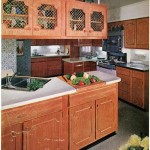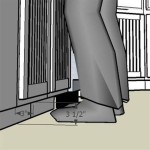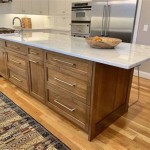Kitchen Cabinets Wood Grain Direction
Wood grain, the naturally occurring pattern in lumber caused by the arrangement of wood fibers, plays a significant role in the aesthetic appeal and structural integrity of kitchen cabinets. Understanding wood grain direction is crucial for both cabinet makers and homeowners undertaking kitchen renovations. The direction the grain runs impacts the cabinet's strength, susceptibility to warping, and how it accepts stains and finishes. This article will explore the different types of wood grain directions commonly found in kitchen cabinetry and their respective implications.
Vertical Grain: Vertical or straight grain refers to lumber where the wood fibers run parallel to the length of the board. This configuration offers superior strength and stability, making it less prone to warping or twisting. Cabinets constructed with vertical grain wood tend to have a clean, uniform appearance, as the wood fibers absorb stains and finishes evenly. Due to its inherent strength and stability, vertical grain lumber is often preferred for cabinet doors, drawer fronts, and structural components where durability is paramount. However, vertical grain lumber can be more expensive due to the higher yield loss during the milling process.
Horizontal Grain: In horizontal or flat grain lumber, the wood fibers run perpendicular to the length of the board, appearing as a series of growth rings on the face. While horizontal grain lumber is generally more readily available and less expensive than vertical grain, it is more susceptible to expansion and contraction due to changes in humidity. This can lead to warping, cupping, or bowing, particularly in wider cabinet components like doors and drawer fronts. Horizontal grain wood also tends to exhibit a more pronounced grain pattern, which can be aesthetically appealing but may require careful sanding and finishing to achieve a smooth, even surface.
Cathedral Grain: Cathedral grain refers to a distinctive pattern where the wood fibers create an arched or "cathedral" like appearance. This pattern results from cutting through the growth rings at an angle, producing a visually striking effect. While aesthetically pleasing, cathedral grain can present challenges during the manufacturing process. The changing grain direction can make the wood more prone to chipping or splintering during machining. Additionally, achieving a uniform finish can be more difficult due to the varying densities within the grain pattern.
Rotary Cut Grain: This type of grain is produced by rotating a log against a blade, similar to peeling a roll of paper. This method yields thin sheets of veneer with a broad, swirling grain pattern. Rotary cut veneer is often used as a surface layer on less expensive substrates like particleboard or MDF to create the appearance of solid wood. While cost-effective, rotary cut veneer is more susceptible to damage and delamination compared to solid wood.
Quarter Sawn Grain: This method involves sawing the log into quarters and then cutting boards radially from each quarter. Quarter sawn lumber exhibits a straight, tight grain pattern with distinctive flecking or medullary rays. It offers exceptional stability, resisting warping, twisting, and shrinking. While highly desirable for its stability and aesthetic appeal, quarter sawn lumber is typically more expensive due to the specialized milling process and lower yield.
Rift Sawn Grain: Similar to quarter sawn, rift sawing involves cutting lumber perpendicular to the growth rings. This results in a linear grain pattern that is even straighter than quarter sawn lumber, minimizing the appearance of growth rings. Rift sawn lumber offers exceptional stability and is highly prized for its uniform appearance, making it ideal for high-end cabinetry. However, the specialized milling process results in a lower yield and consequently a higher price point.
Impact of Grain Direction on Finishing: Wood grain direction significantly influences how cabinets accept stains and finishes. Vertical grain wood, with its uniform fiber structure, absorbs stains evenly, resulting in a consistent color. Horizontal grain, on the other hand, can absorb stains unevenly, leading to a blotchy or streaky appearance. This is particularly noticeable with darker stains. Understanding the grain direction is crucial for selecting appropriate finishing techniques and achieving the desired aesthetic result.
Considerations for Cabinet Selection: When selecting kitchen cabinets, consider the wood species, grain direction, and construction method. For areas prone to moisture, such as near the sink or dishwasher, opt for cabinets constructed with vertical or quarter sawn lumber for enhanced stability. For cabinet doors and drawer fronts, the choice between horizontal, vertical, or cathedral grain often comes down to aesthetic preference and budget. Horizontal grain offers a more pronounced grain pattern and is generally less expensive, while vertical grain provides superior stability and a cleaner appearance.
Working with Wood Grain: Understanding wood grain direction is crucial for any woodworking project involving kitchen cabinets. Cutting against the grain can lead to tear-out and splintering, while sanding against the grain can create scratches that are difficult to remove. Always cut and sand with the grain for optimal results. When assembling cabinets, ensure that adjoining pieces have compatible grain directions to minimize the risk of warping or cracking.
Long-Term Care and Maintenance: Proper care and maintenance can help preserve the beauty and longevity of kitchen cabinets, regardless of the wood grain direction. Avoid exposing cabinets to excessive moisture or temperature fluctuations. Regular cleaning with a soft cloth and mild detergent can help prevent buildup of grease and grime. Periodically apply furniture polish or wax to protect the finish and maintain the wood's natural luster.

Grain Vs No Wood Finishes Solid Colors

Cabinet Wood Grain Direction An Ideabook By Christine Povinelli

Upper Wood Grain Direction Change Casas Bancada

Cabinet Wood Grain Direction An Ideabook By Christine Povinelli

Grain Direction In Euro Style Kitchen Canadian Woodworking And Home Improvement Forum

Vertical Grain Kitchen Cabinets Crystal

Cabinet Wood Grain Direction An Ideabook By Christine Povinelli

Norelco Cabinets Grain Match Vs Non

Trend Study Horizontal Grain Cabinets Make Kitchen Designs Modern Natural Dura Supreme Cabinetry

Vertical Grain Kitchen Cabinets Crystal








